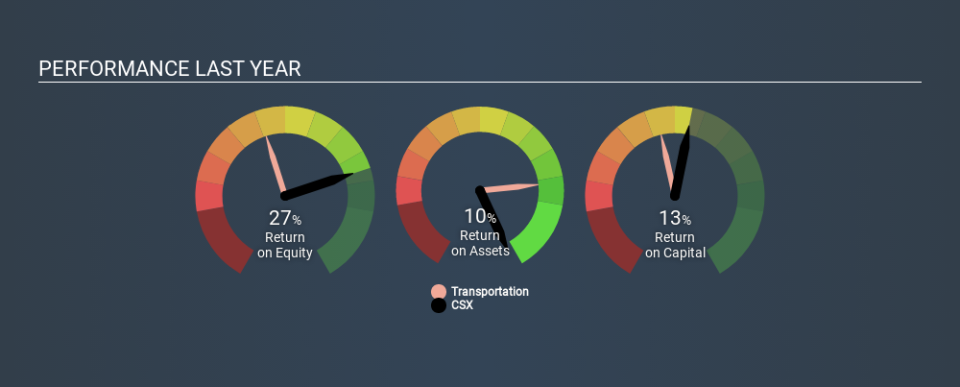Why CSX Corporation’s (NASDAQ:CSX) Return On Capital Employed Is Impressive

Today we'll evaluate CSX Corporation (NASDAQ:CSX) to determine whether it could have potential as an investment idea. Specifically, we'll consider its Return On Capital Employed (ROCE), since that will give us an insight into how efficiently the business can generate profits from the capital it requires.
First of all, we'll work out how to calculate ROCE. Then we'll compare its ROCE to similar companies. Then we'll determine how its current liabilities are affecting its ROCE.
Return On Capital Employed (ROCE): What is it?
ROCE is a measure of a company's yearly pre-tax profit (its return), relative to the capital employed in the business. In general, businesses with a higher ROCE are usually better quality. Ultimately, it is a useful but imperfect metric. Author Edwin Whiting says to be careful when comparing the ROCE of different businesses, since 'No two businesses are exactly alike.
So, How Do We Calculate ROCE?
Analysts use this formula to calculate return on capital employed:
Return on Capital Employed = Earnings Before Interest and Tax (EBIT) ÷ (Total Assets - Current Liabilities)
Or for CSX:
0.13 = US$4.9b ÷ (US$39b - US$2.2b) (Based on the trailing twelve months to March 2020.)
So, CSX has an ROCE of 13%.
See our latest analysis for CSX
Is CSX's ROCE Good?
One way to assess ROCE is to compare similar companies. CSX's ROCE appears to be substantially greater than the 11% average in the Transportation industry. We would consider this a positive, as it suggests it is using capital more effectively than other similar companies. Separate from CSX's performance relative to its industry, its ROCE in absolute terms looks satisfactory, and it may be worth researching in more depth.
Our data shows that CSX currently has an ROCE of 13%, compared to its ROCE of 10% 3 years ago. This makes us wonder if the company is improving. You can click on the image below to see (in greater detail) how CSX's past growth compares to other companies.
Remember that this metric is backwards looking - it shows what has happened in the past, and does not accurately predict the future. Companies in cyclical industries can be difficult to understand using ROCE, as returns typically look high during boom times, and low during busts. ROCE is only a point-in-time measure. What happens in the future is pretty important for investors, so we have prepared a free report on analyst forecasts for CSX.
Do CSX's Current Liabilities Skew Its ROCE?
Current liabilities include invoices, such as supplier payments, short-term debt, or a tax bill, that need to be paid within 12 months. The ROCE equation subtracts current liabilities from capital employed, so a company with a lot of current liabilities appears to have less capital employed, and a higher ROCE than otherwise. To counteract this, we check if a company has high current liabilities, relative to its total assets.
CSX has current liabilities of US$2.2b and total assets of US$39b. As a result, its current liabilities are equal to approximately 5.7% of its total assets. In addition to low current liabilities (making a negligible impact on ROCE), CSX earns a sound return on capital employed.
The Bottom Line On CSX's ROCE
If CSX can continue reinvesting in its business, it could be an attractive prospect. CSX shapes up well under this analysis, but it is far from the only business delivering excellent numbers . You might also want to check this free collection of companies delivering excellent earnings growth.
For those who like to find winning investments this free list of growing companies with recent insider purchasing, could be just the ticket.
Love or hate this article? Concerned about the content? Get in touch with us directly. Alternatively, email editorial-team@simplywallst.com.
This article by Simply Wall St is general in nature. It does not constitute a recommendation to buy or sell any stock, and does not take account of your objectives, or your financial situation. We aim to bring you long-term focused analysis driven by fundamental data. Note that our analysis may not factor in the latest price-sensitive company announcements or qualitative material. Simply Wall St has no position in any stocks mentioned. Thank you for reading.

 Yahoo Finanzen
Yahoo Finanzen 
